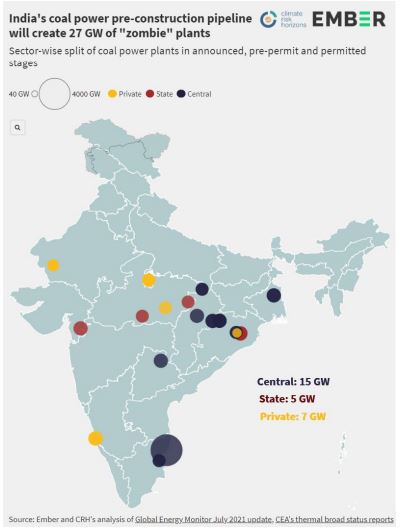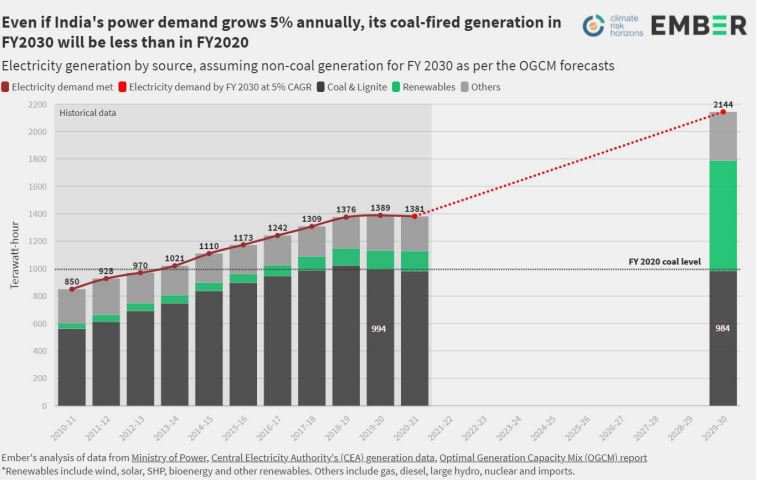Power generation surplus, proposed 27 GW of thermal power plants superfluous to India’s energy need: Report
An analysis by two advocacy groups reveals that hinging on the coal-powered thermal power plants is detrimental to not only India's sustainable development goals but also unnecessary in the light of India’s energy needs. Details here.


The report stated that India can meet peak demand in Financial Year 2030 even if it retires its old coal plants and stops building new coal beyond those under construction.
Taking note of the change in India’s power sector landscape, advocacy groups have pointed out that coal powered power plant projects that are in the pipeline would compromise the country’s development goals both economically and in terms of its commitment to sustainable development goals. These proposed power plants would generate 27 gigawatts of power.
The findings were concluded in a report titled ‘India’s Zombie Threat – 27 GW of Unnecessary Planned Coal Power Plants’ jointly published by Ember, an international climate and energy think tank and Climate Risk Horizon, a Bengaluru-based climate advocacy group.
“Analysis by Ember and Climate Risk Horizons (CRH) shows that 27 GW of prepermit and permitted new coal power plant proposals are now superfluous to requirements and will likely end up as “zombie” plants— assets that will be neither dead nor alive. These surplus plants, if built, will suck in scarce resources and impede India’s renewable energy (RE) ambitions. But they can be cancelled without needing to sacrifice the power system’s ability to meet future demand,” the report notes.
Explained: How air pollution affects monsoon rains in India

Furthermore, the report also stated that India can meet peak demand in Financial Year 2030 even if it retires its old coal plants and stops building new coal beyond those under construction.
“By FY 2030, India will have a total ‘firm’ capacity of about 346 GW in addition to 420 GW of variable renewables capacity to meet an estimated peak demand of 301 GW,” it highlighted.

It also suggested that daytime peak demand would be easily met with India’s huge planned solar capacity, while claiming that evening peaks will be most effectively met by additional battery storage, at a lower cost than building new coal powered plants.
The report also argues that switching investment from coal projects to renewables and battery storage would save the Indian power system an additional Rs. 43,219 crores (US $4 billion) a year from 2027 onwards in terms of reduced power purchase cost – in addition to capex savings – without sacrificing the power system’s ability to meet future demand.
Also Read: Coal ash: ‘White prawns turned into ash prawns; fishers pushed into poverty’

“As India recovers from the disruption caused by the COVID-19 pandemic, how the country uses scarce public resources will be absolutely crucial. By avoiding the unnecessary “zombie” coal plants, India can not only save lakhs of crores of rupees, but also lower power costs and reiterate its commitment to the success of its clean energy transition goals,” Aditya Lolla, Senior Electricity Policy Analyst, Ember was quoted.
Key findings
- India does not require additional new coal capacity to meet expected demand growth by 2030. Even if India’s power demand grows 5 per cent annually, in line with the most optimistic International Energy Agency (IEA) projection, coal-fired generation in 2030 will be lower than in 2020 as long as India achieves its non-coal generation targets. In effect, more coal capacity beyond what’s already under construction isn’t needed to meet the aggregate demand growth by 2030.
- India can meet its peak demand in 2030 without building the “zombie” coal plants. India’s peak demand would reach 301 GW by 2030, assuming it grows at an annual growth rate five per cent in line with the Central Electricity Authority (CEA) projections. This is about 40 GW less than the OGCM forecast. If this peak occurs during sunlight hours as recent studies predict, India’s planned solar capacity can cover much of it. Even if it occurs in the evening, substituting the “zombie” coal plants with additional battery storage capacity represents a more flexible, cheaper option.
- India can free up Rs. 247,421 crore in capex by killing the ‘zombie’ coal projects. These surplus plants, if built, will require an estimated Rs. 247,421 crore (US $33 billion) of investment. They will lock consumers into expensive contracts and jeopardise India’s renewable energy goals by adding to the system’s overcapacity.
- India can make annual savings of Rs. 43,219 crores by investing in renewables and storage, instead of “zombie” coal projects. Substituting 27 GW of coal with battery storage will save the Indian power system Rs. 43,219 cr (US $6 billion) a year in terms of reduced power purchase cost. In addition, building 30 GW of additional battery storage rather than the “zombie” coal plants will require an estimated Rs. 109,800 cr (US $15 billion) capex, implying a savings by way of avoided investment of nearly Rs 137,621 crores (US $18 billion).
Also Read: Maharashtra can save Rs 750 billion in next 10 years. Here’s how

